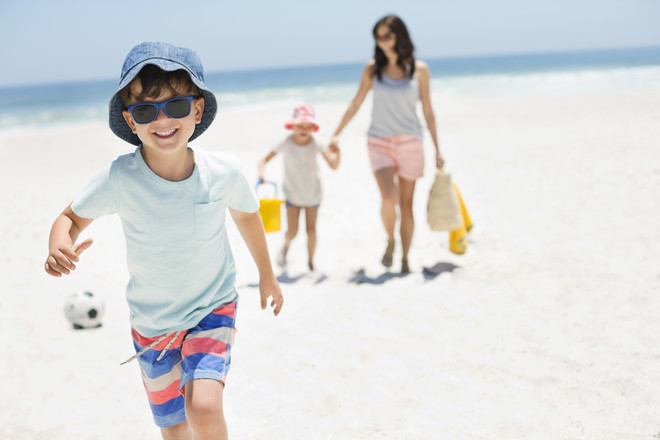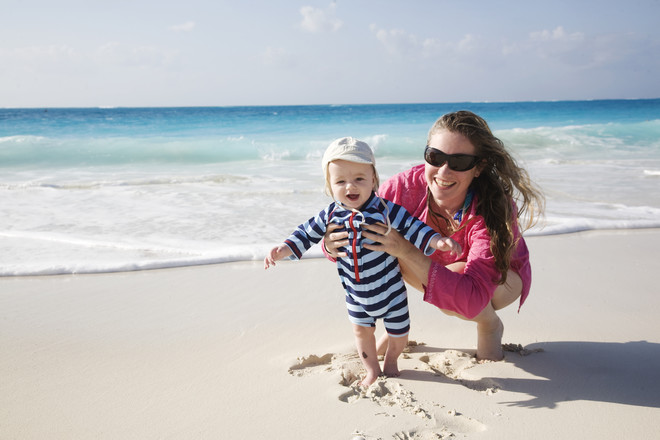Summer is a great time. Vacations, holidays ... But also very dangerous. In the summer of accidents with children, there is always more. Children fall into an accident, fall out of the windows, sink ... How to avoid the tragedies associated with beach vacation, said our consultant Andrei Grankin, the head of the water rescue unit of the municipal budgetary establishment "HimSpas."
9 main rules of behavior on the water
1.Choose for recreation only those bodies of water where swimming is officially permitted. With the onset of the season, their bottoms are cleared of garbage, and lifeguards are on duty at the beaches. 2. Enter the water in suits designed for this purpose. Teenagers often swim in shorts and a T-shirt. Water collects in pockets, clothes restrict movement and pull you to the bottom. In an emergency, excess weight can become critical. Photo: GettyImages3. Young children wear armlets. If the swimmer loses consciousness, they will not allow to lower the head into the water and drown. The sleeves must be inflated to the tip and sit tightly on the arm. Before buying, make sure that they are designed for the right age. Collect long hair in a pigtail or a tight bundle. Loose curls can get into the nose or mouth, make breathing difficult. At an air temperature above 30 degrees, you must not rush into the water from a take-off. This rule must be observed by both children and adults. The heart can not withstand the difference in temperature - air, body, upper and lower layers of water. Slowly go to shallow water, plunge with your head, without leaving the place, wait five minutes and swim. Take into account: from long distances in the heat it is better to refrain. 6. Do not swim and especially do not dive in unfamiliar places and where you have not been for a long time. First check the bottom. Reservoirs with opaque water should be inspected every time, especially if there is a current, it can bring a snag. Do not dive if the kids are floundering around the shore. 7. Come with the child into the water together. The baby is able to drown even at a depth of no more than 20-30 cm. It is not enough to observe from the shore. We decided to take a ride on a boat - put a life ring or rope on the bottom, put on life jackets on children. Always remind that you can not indulge in water on the water, pretend that you are drowning. 9. Teach the kids the rule: tired - lie down on your back and rest, cramped leg - several times hard to pinch the skin. For adults the same recommendation, and if on a swimsuit or swimming trunks there is an ornament with a pin, a leg is better to prick.
Photo: GettyImages3. Young children wear armlets. If the swimmer loses consciousness, they will not allow to lower the head into the water and drown. The sleeves must be inflated to the tip and sit tightly on the arm. Before buying, make sure that they are designed for the right age. Collect long hair in a pigtail or a tight bundle. Loose curls can get into the nose or mouth, make breathing difficult. At an air temperature above 30 degrees, you must not rush into the water from a take-off. This rule must be observed by both children and adults. The heart can not withstand the difference in temperature - air, body, upper and lower layers of water. Slowly go to shallow water, plunge with your head, without leaving the place, wait five minutes and swim. Take into account: from long distances in the heat it is better to refrain. 6. Do not swim and especially do not dive in unfamiliar places and where you have not been for a long time. First check the bottom. Reservoirs with opaque water should be inspected every time, especially if there is a current, it can bring a snag. Do not dive if the kids are floundering around the shore. 7. Come with the child into the water together. The baby is able to drown even at a depth of no more than 20-30 cm. It is not enough to observe from the shore. We decided to take a ride on a boat - put a life ring or rope on the bottom, put on life jackets on children. Always remind that you can not indulge in water on the water, pretend that you are drowning. 9. Teach the kids the rule: tired - lie down on your back and rest, cramped leg - several times hard to pinch the skin. For adults the same recommendation, and if on a swimsuit or swimming trunks there is an ornament with a pin, a leg is better to prick.
If the trouble did happen
- If the child starts to drown, shout so thatheard from the shore. Do not rely on your own strength. Let others know what happened. It often happens that, having pulled the child out, the parents are in a state of shock and cannot provide first aid. - If the drowning child is conscious, grab him by the shoulders and try to avoid attempts to grab you. On the shore, take off wet clothes and take the baby as far away from the water as possible, this will minimize psychological trauma. The child has lost consciousness - take him with your hand under the chin so that the face is above the surface of the water. Having got to the shore, ask to call the medics and begin to provide first aid. - The pulse is palpable, but the child is not breathing - perform artificial respiration. Twist a bolster out of clothes and place it under the neck, fix the head by placing your palms on the forehead and chin of the victim. You need to take 35 breaths per minute if the baby is an infant, 30 - a junior, 20 - a schoolchild. No pulse – alternate artificial respiration with indirect heart massage. Lay the child on a hard surface and kneel next to him. For babies, press on the middle of the sternum with the index and middle fingers, for children under 8 – with the palm of one hand. For schoolchildren, place both palms, one on top of the other, on the lower third of the sternum. For five presses, take one breath. If there are assistants, do artificial respiration and massage simultaneously. After the child’s breathing is restored, continue artificial respiration until the skin turns pink. Then wrap up and show to the doctor. Photo: GettyImages
Photo: GettyImages
Be careful, strike!
1.During rest, a child may get sunstroke or heatstroke. Follow the rules to avoid it and learn how to provide first aid. 2. Do not go outside with your child from 12 to 15 o'clock, avoid increased physical activity at this time. 3. Protect your head from direct sunlight, dress your baby in clothes made of natural materials in light colors. 4. Take a sufficient supply of drinks with you. Not only water, but also kvass, juice, tea will do. Make sure that your child drinks regularly. 6. If you cannot avoid a blow, take the baby to the shade, undress and lay him down so that his legs are higher than his head. If the condition is serious, call an ambulance. 7. Wipe the child's body with a cloth or sponge soaked in water. Keep in mind that the water should not be icy, but cool. Make a wet compress on the forehead. 8. You can dip the baby in a river or pond if the water temperature is not lower than 18 and not higher than 20 degrees. 9. Make a fan and fan the baby to ensure air flow. 10. The most important thing is to let the baby drink as much warm water as possible in small sips.









